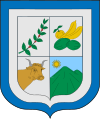San Francisco, Cundinamarca
| San Francisco | |||
|---|---|---|---|
| Municipality and town | |||
 |
|||
|
|||
| Motto(s): Manos a la obra | |||
 Location of San Francisco in Cundinamarca |
|||
| Country |
|
||
| Department |
|
||
| Region | Gualivá Province | ||
| Foundation | 22 de noviembre de 1857 | ||
| Government | |||
| • Mayor | Martha Libia Gaitán González, | ||
| Area | |||
| • Municipality and town | 118 km2 (46 sq mi) | ||
| Elevation | 1,520 m (4,990 ft) | ||
| Population (2005) | |||
| • Municipality and town | 8,187 | ||
| • Density | 69/km2 (180/sq mi) | ||
| • Urban | 2,851 | ||
| Area code(s) | 57 + 1 | ||
| Website | Official Site (in Spanish) | ||
San Francisco de Sales, commonly known as San Francisco (Spanish pronunciation: [sam fɾanˈsisko]), is a municipality and town of Colombia in the department of Cundinamarca.
San Francisco de Sales is bounded on the north by the municipality of Supatá, the west by La Vega, on the south by Facatativá, to the southeast by El Rosal, and on the east by Subachoque. The town of San Francisco has about one-third the population of the municipality, with the rest living in the rural districts of Arrayán, El Peñón, Juan de Vera, La Laja, Muña, Pueblo Viejo, Sabaneta, San Antonio, San Miguel, and Tóriba.
The municipality is within temperate and cold climatic zones, and has a geomorphology of moorland (páramo bajo). The municipality has an average temperature of 20 °C (68 °F) in most of the territory, with an average annual rainfall of 1.493 metres (58.8 in). It is located 52 kilometres (32 mi) away from Bogotá; this distance, with its climate, scenery, water resources and other features make it attractive for tourism.
San Francisco is in the Diocese of Facatativá.
The area was inhabited by the Panches, part of the Carib family, and Muisca, part of the Chibcha family. The Muisca lived in the southeastern part of the current municipality where it borders the municipality of El Rosal, where they established a fort to prevent access of the Panche Nation to the Confederation of Bacatá, whose sovereign was the Zipa and was located in the Sabana de Bogota .
In the colonial period, because the foundation of the municipality of Tenjo, six encomiendas were created, to which the indigenous people of that area were assigned. One of the encomiendas in the vicinity of Subachoque, was assigned to the Spanish citizen Don Juan de Vera, who named his property "Chinga Fría"; in Mexican Spanish chinga means "fuck", and in the Chibcha language means "wildness" or "bravery".
Then, between 1605 and when the neighboring town of La Vega was founded, Don Juan de Vera exchanged his encomienda "Chinga Fría" for another property. This new encomienda was named San José de Chinga Caliente; San José to give it a Christian name, and hot to distinguish it from the previous one in a colder area. Later, around 1750, these lands were acquired by Pedro Pulido, from the municipality of Tenjo. In 1828, Francisca Sánchez, from Tabio, bought the hacienda San José de Chinga Caliente from Pulido. Francisca Sánchez married the French citizen Francisco Convers in 1833. After 1850, the couple built the house that would later be called La Carlina, because the mansion of the encomienda was extremely run down.
...
Wikipedia


